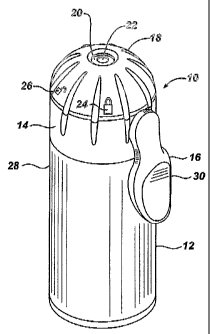Some of the information on this Web page has been provided by external sources. The Government of Canada is not responsible for the accuracy, reliability or currency of the information supplied by external sources. Users wishing to rely upon this information should consult directly with the source of the information. Content provided by external sources is not subject to official languages, privacy and accessibility requirements.
Any discrepancies in the text and image of the Claims and Abstract are due to differing posting times. Text of the Claims and Abstract are posted:
| (12) Patent: | (11) CA 2518483 |
|---|---|
| (54) English Title: | HAND-HELD PRODUCT DISPENSERS HAVING PRESSURIZED DELIVERY |
| (54) French Title: | DISTRIBUTEURS A MAIN DE PRODUITS AYANT UNE DISTRIBUTION SOUS PRESSION |
| Status: | Deemed expired |
| (51) International Patent Classification (IPC): |
|
|---|---|
| (72) Inventors : |
|
| (73) Owners : |
|
| (71) Applicants : |
|
| (74) Agent: | MACRAE & CO. |
| (74) Associate agent: | |
| (45) Issued: | 2008-09-23 |
| (86) PCT Filing Date: | 2004-03-23 |
| (87) Open to Public Inspection: | 2004-10-14 |
| Examination requested: | 2005-09-07 |
| Availability of licence: | N/A |
| (25) Language of filing: | English |
| Patent Cooperation Treaty (PCT): | Yes |
|---|---|
| (86) PCT Filing Number: | PCT/US2004/008769 |
| (87) International Publication Number: | WO2004/087532 |
| (85) National Entry: | 2005-09-07 |
| (30) Application Priority Data: | ||||||
|---|---|---|---|---|---|---|
|
A hand-held pressurized product dispenser (10) including a container (12)
containing a product under pressure, a valve mechanism and base structure (14)
at the top of the container, a nozzle (20) that moves between an unactuated
position and a discharge position, and a side lever (16) that extends along
the can (12) and is movable to move the nozzle from the unactuated position to
the discharge position. The dispenser also has a dome (18) that is rotatably
connected to the base structure and surrounds the nozzle and interacts with
the nozzle to cause rotation of the nozzle between a locked position and an
unlocked position. The nozzle has one or more downwardly directed feet (46)
that align with solid areas of an upwardly directed surface in the locked
position and that align with open areas (52) of the base structure in the
unlocked position, such that the nozzle is free to move into the discharge
position.
L'invention concerne un distributeur 10 à main de produits sous pression comprenant un conteneur 12 contenant un produit sous pression, un mécanisme de valve et une structure de base 14 sur la partie supérieure du conteneur, une buse 20 de déplacement entre une position d'arrêt et une position de décharge, et un levier latéral s'étendant le long de la canette 12 et se déplaçant de manière à faire passer la buse de la positon d'arrêt à la position de décharge. Le distributeur comporte également un dôme 18 relié de manière rotative à la structure de base et entourant la buse et interagissant avec celle-ci de manière à la faire tourner entre une position bloquée et une position débloquée. La buse comprend un ou plusieurs pieds 46 dirigés vers le bas s'alignant sur des zones solides d'une surface orientée vers le haut en position bloquée et s'alignant sur des zones ouvertes 52 de la structure de base en position débloquée, de manière à pouvoir se déplacer librement dans la position de décharge.
Note: Claims are shown in the official language in which they were submitted.
Note: Descriptions are shown in the official language in which they were submitted.

For a clearer understanding of the status of the application/patent presented on this page, the site Disclaimer , as well as the definitions for Patent , Administrative Status , Maintenance Fee and Payment History should be consulted.
| Title | Date |
|---|---|
| Forecasted Issue Date | 2008-09-23 |
| (86) PCT Filing Date | 2004-03-23 |
| (87) PCT Publication Date | 2004-10-14 |
| (85) National Entry | 2005-09-07 |
| Examination Requested | 2005-09-07 |
| (45) Issued | 2008-09-23 |
| Deemed Expired | 2011-03-23 |
There is no abandonment history.
| Fee Type | Anniversary Year | Due Date | Amount Paid | Paid Date |
|---|---|---|---|---|
| Request for Examination | $800.00 | 2005-09-07 | ||
| Registration of a document - section 124 | $100.00 | 2005-09-07 | ||
| Application Fee | $400.00 | 2005-09-07 | ||
| Maintenance Fee - Application - New Act | 2 | 2006-03-23 | $100.00 | 2005-09-07 |
| Registration of a document - section 124 | $100.00 | 2007-02-09 | ||
| Maintenance Fee - Application - New Act | 3 | 2007-03-23 | $100.00 | 2007-03-08 |
| Maintenance Fee - Application - New Act | 4 | 2008-03-25 | $100.00 | 2008-03-06 |
| Final Fee | $300.00 | 2008-07-08 | ||
| Maintenance Fee - Patent - New Act | 5 | 2009-03-23 | $200.00 | 2009-03-02 |
Note: Records showing the ownership history in alphabetical order.
| Current Owners on Record |
|---|
| THE DIAL CORPORATION |
| Past Owners on Record |
|---|
| GROH, DAVID M. |
| O'CONNOR, WILLIAM T. |
| THE GILLETTE COMPANY |
| TROTTA, ROBERT |